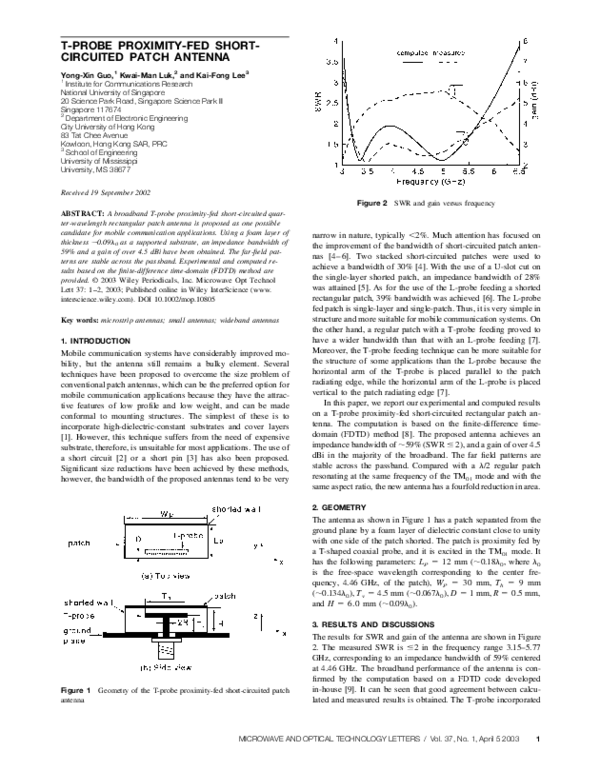Academia.edu no longer supports Internet Explorer.
To browse Academia.edu and the wider internet faster and more securely, please take a few seconds to upgrade your browser.
T-probe proximity-fed short-circuited patch antenna
T-probe proximity-fed short-circuited patch antenna
2003, Microwave and Optical Technology Letters
Related Papers
We suggest in this work a new type of patch antenna feeding, namely, T-shaped probe. In comparison to the known L-shaped probe, the T-shaped one permits to increase the coupling between the feeding line and the radiator. Two patch antennas configurations are presented which consist of a rectangular radiator proximity coupled to a T-shaped probe. In the first configuration, the input return loss bandwidth is increased significantly and also with a size reduction in comparison to the patch antenna with L-probe. In the second configuration, the antenna is combined with parasitic loops and this allows one to increase further the bandwidth and improve the impedance matching within the entire operating bandwidth.
The quarter wave rectangular patch microstrip antenna was chosen as element importing mobile communication because it’s a lower size than the half wave rectangular patch antenna (conventional patch antenna). The feeding is making by a coaxial line because of its simple realization and its direct contact with the patch. The conventional method of impedance matching allows changing the position of the coaxial probe. The inductance introduced by this last is compensates by a capacity which leads to another resonance frequency in the structure of the antenna. This communication is dedicated to the conception of the quarter wave rectangular patch microstrip antenna in the band 'S' (range of frequencies located between 1.55 GHz and 5.2 GHz) which introduces a simple resonant structure with a long coaxial probe. We also represent a means to compensate the inductance of this probe. The quarter wave rectangular patch with large band is located on a thick substrate, what represents defy for conception remaining to the inductance caused by the feeding of the coaxial probe. Problems will be resolved and methods of conception will be suggested. The GLC method of parallel circuit will be used to acquire the width of the bandwidth of the quarter wave antenna. We will compare our results then with FDTD method (Finite Difference Time Domain) and TLM method (transmission Line Model).
2020 •
1Research scholar, Department of Physics and Electronics Dr. Rammanohar Lohia Avadh University Ayodhya.U.P, India 2Prof. K.K.Verma Professor, Department of Physics and Electronics Dr. Rammanohar Lohia Avadh University Ayodhya. U.P, India 3Himanshu Bhusan Baskey DMSRDE (DRDO), Kanpur U.P, India ---------------------------------------------------------------------***---------------------------------------------------------------------Abstract This paper presents a comparative study of coaxial probe feed rectangular microstrip patch antenna and proximity coupled feed rectangular microstri patch antenna. The operation (resonant) frequency (fo) for the both is 2.4GHz which is suitable for short range wireless application .Coaxial probe feed rectangular microstrip patch antenna is designed on FR-4 substrate (lossy) of dielectric constant 4.3 having height of 1.6mm. Whereas proximity coupled feed rectangular patch antenna is designed on substrate FR-4(lossy) and Rogers R03003 (lossy) havin...
IEEE Antennas and Propagation Magazine
A note on the impedance variation with feed position of a rectangular microstrip-patch antenna2004 •
Progress In Electromagnetics Research Letters
Design of Single Pin Shorted Three-Dielectric-Layered Substrates Rectangular Patch Microstrip Antenna for Communication Systems2008 •
Microwave and Optical Technology Letters
Circuit model and near-field behavior of a novel patch antenna for WWLAN applications2007 •
International Journal of Engineering Research and Technology (IJERT)
IJERT-Coaxial Probe Fed T-Shaped Patch Antenna for Wideband Applications2013 •
https://www.ijert.org/coaxial-probe-fed-t-shaped-patch-antenna-for-wideband-applications https://www.ijert.org/research/coaxial-probe-fed-t-shaped-patch-antenna-for-wideband-applications-IJERTV2IS110406.pdf The aim of this paper is to design a T-shaped patch antenna with coaxial probe feed at appropriate location and compare its bandwidth with conventional microstrip feed line patch antenna. Performance parameters like return loss, VSWR, smith chart are analyzed using HFSS Software v.13. Bandwidth of antenna is found to be enhanced from 0.43GHz to 2.68GHz w.r.t conventional antenna. We have observed that etching slots in patch further improves the S 11 parameter for return loss from-23.5dB to-72.24dBand minimize the vswr to 1.08. Maintaining compact size of antenna with improved characteristics makes it perfect for wireless applications with high data rate. Details of the antenna design and resulting parameters are presented and discussed.
RELATED PAPERS
2018 •
2010 •
Debate feminista
Las relaciones sexo afectivas en la cuarta ola feminista: diagnósticos, debates y propuestas (Argentina, 2018-2022)2023 •
Aevum Rassegna di Scienze StoricheLinguistiche E Filologiche
In margine a un glossario del IX secolo: il Libellus de situ civitatis Mediolani2022 •
Humanities and Social Sciences Communications
A dynamic linkage between greenhouse gas (GHG) emissions and agricultural productivity: evidence from Ethiopia2024 •
2019 •
2005 •
2024 •
Materials Science and Engineering: C
Novel tetraphenylethylene diol amphiphile with aggregation-induced emission: self-assembly, cell imaging and tagging property2017 •
International Journal of Environmental Research and Public Health
Accept Anxiety to Improve Sleep: The Impact of the COVID-19 Lockdown on the Relationships between Mindfulness, Distress, and Sleep Quality2021 •
The Journal of Clinical Endocrinology and Metabolism
The Adrenal Vein Sampling International Study (AVIS) for Identifying the Major Subtypes of Primary Aldosteronism2012 •
British Journal of Pharmacology
In vitro and in vivo pharmacological characterization of the novel UT receptor ligand [Pen5,DTrp7,Dab8]urotensin II(4–11) (UFP‐803)2006 •
RELATED TOPICS
- Find new research papers in:
- Physics
- Chemistry
- Biology
- Health Sciences
- Ecology
- Earth Sciences
- Cognitive Science
- Mathematics
- Computer Science

 Kwai Man Luk
Kwai Man Luk